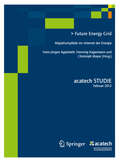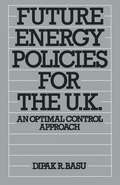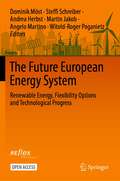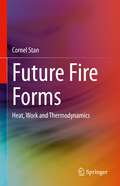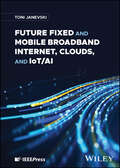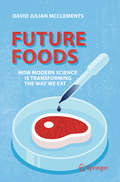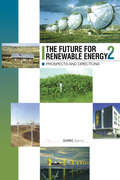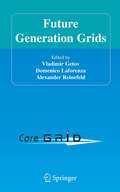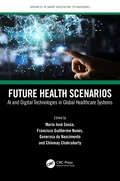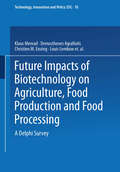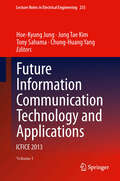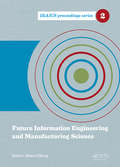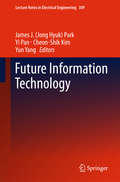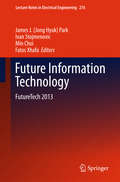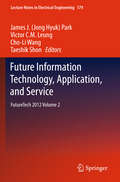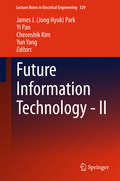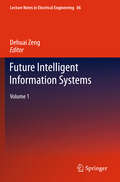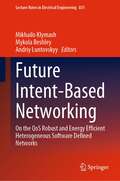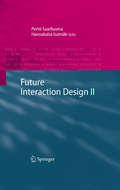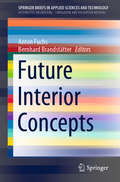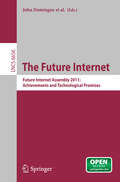- Table View
- List View
Future Energy Grid: Migrationspfade in das Internet der Energie (acatech STUDIE)
by Hans-Jürgen AppelrathBis 2022 will Deutschland aus der Kernenergie aussteigen und zügig auf eine Energieversorgung auf der Grundlage erneuerbarer Energien wie Wind- oder Sonnenenergie umstellen. Diese lassen sich in großem Umfang nur mithilfe von Informations- und Kommunikationstechnologien (IKT) in das Elektrizitätssystem integrieren. In einem sogenannten Smart Grid verschmelzen IKT und Energietechnik und sorgen für nachhaltigen, zuverlässigen und bezahlbaren Strom. Die Studie beschreibt, welcher Migrationspfad in das in das Future Energy Grid bis zum Jahr 2030 zu beschreiten ist. Die Autoren skizzieren dazu in drei bildhaften Szenarien die möglichen Entwicklungen des Energiesystems in Deutschland und benennen die notwendigen technologischen Schritte in das wünschenswerte System einer nachhaltig-wirtschaftlichen Stromversorgung.
The Future European Energy System: Renewable Energy, Flexibility Options and Technological Progress
by Dominik Möst Steffi Schreiber Andrea Herbst Martin Jakob Angelo Martino Witold-Roger PoganietzThis open access book analyzes the transition toward a low-carbon energy system in Europe under the aspects of flexibility and technological progress. By covering the main energy sectors – including the industry, residential, tertiary and transport sector as well as the heating and electricity sector – the analysis assesses flexibility requirements in a cross-sectoral energy system with high shares of renewable energies. The contributing authors – all European energy experts – apply models and tools from various research fields, including techno-economic learning, fundamental energy system modeling, and environmental and social life cycle as well as health impact assessment, to develop an innovative and comprehensive energy models system (EMS). Moreover, the contributions examine renewable penetrations and their contributions to climate change mitigation, and the impacts of available technologies on the energy system. Given its scope, the book appeals to researchers studying energy systems and markets, professionals and policymakers of the energy industry and readers interested in the transformation to a low-carbon energy system in Europe.
Future Fire Forms: Heat, Work and Thermodynamics
by Cornel StanKeep on running by clever burning! This book reports how humans created materials, machines and power plants with the help of fire and which fuels, with their advantages and disadvantages, they have used so far. "Climate rescuers” of all stripes, whether qualified for such challenge or not, want to eliminate the fire completely and replace it with electricity from photovoltaics and wind power.The book contains facts and evidence as to why solar panels and windmills cannot be sufficient to ensure all the world's energy needs. Neither combustion nor thermal engines are responsible for the environmental hazard till now, but the fuels they have received in the past. Let's feed the fire with nature-compatible fuels and let it unfold properly in very effective machines and systems! The book describes systematically and comprehensibly for everyone, thermodynamic laws and methods for the design of very efficient machines and drives, as well as regenerative, climate-neutral fuels. This lecture is highly recommended when seating in front of a fireplace or sitting beside a campfire.
Future Fixed and Mobile Broadband Internet, Clouds, and IoT/AI
by Toni JanevskiFUTURE FIXED AND MOBILE BROADBAND INTERNET, CLOUDS, AND IoT/AI All-in-one resource on the development of Internet and telecoms worldwide, based on the technological frameworks as defined by the ITU Future Fixed and Mobile Broadband Internet, Clouds, and IoT/AI is a highly comprehensive resource that provides full coverage of existing and future fixed and mobile broadband networks, internet, and telecom and OTT services. This book explains how to perform technical, business, and regulatory analysis for future 5G-Advanced, 6G, WiFi, and optical access. This book also covers optical transport, submarine cable, future satellite broadband, cloud computing, massive and critical IoT and frameworks and use of AI / ML in telecommunications. Topics covered include: Internet technologies, IPv6, QUIC, DNS, IPX, QoS in Internet/IP, cybersecurity, future Internet 2030, Internet governance Future metallic and optical broadband, carrier-grade Ethernet, SD-WAN, OTN, submarine cable, satellite broadband, business and regulation of broadband Future mobile and wireless broadband, 5G-Advanced, 5G/6G spectrum management, 5G Non-Terrestrial Networks, QoS, 6G/IMT-2030, WiFi 7 (802.11.be), mobile business and regulatory aspects Cloud computing architectures and service models, MLaaS, BaaS, future OTT and telecom cloud services, business and regulation of clouds Future voice, future TV, XR/AR/VR, critical IoT/AI services, future OTT services, metaverse, network neutrality, future digital economy and markets Future Fixed and Mobile Broadband Internet, Clouds, and IoT/AI is an essential reference for government officials and regulators, business leaders, engineers, managers, and employees in the telecommunications industry, ICT business professionals, and students in telecommunications.
Future Fixed and Mobile Broadband Internet, Clouds, and IoT/AI
by Toni JanevskiFUTURE FIXED AND MOBILE BROADBAND INTERNET, CLOUDS, AND IoT/AI All-in-one resource on the development of Internet and telecoms worldwide, based on the technological frameworks as defined by the ITU Future Fixed and Mobile Broadband Internet, Clouds, and IoT/AI is a highly comprehensive resource that provides full coverage of existing and future fixed and mobile broadband networks, internet, and telecom and OTT services. This book explains how to perform technical, business, and regulatory analysis for future 5G-Advanced, 6G, WiFi, and optical access. This book also covers optical transport, submarine cable, future satellite broadband, cloud computing, massive and critical IoT and frameworks and use of AI / ML in telecommunications. Topics covered include: Internet technologies, IPv6, QUIC, DNS, IPX, QoS in Internet/IP, cybersecurity, future Internet 2030, Internet governance Future metallic and optical broadband, carrier-grade Ethernet, SD-WAN, OTN, submarine cable, satellite broadband, business and regulation of broadband Future mobile and wireless broadband, 5G-Advanced, 5G/6G spectrum management, 5G Non-Terrestrial Networks, QoS, 6G/IMT-2030, WiFi 7 (802.11.be), mobile business and regulatory aspects Cloud computing architectures and service models, MLaaS, BaaS, future OTT and telecom cloud services, business and regulation of clouds Future voice, future TV, XR/AR/VR, critical IoT/AI services, future OTT services, metaverse, network neutrality, future digital economy and markets Future Fixed and Mobile Broadband Internet, Clouds, and IoT/AI is an essential reference for government officials and regulators, business leaders, engineers, managers, and employees in the telecommunications industry, ICT business professionals, and students in telecommunications.
Future Foods: How Modern Science Is Transforming the Way We Eat
by David Julian McClementsWe are in the midst of an unprecedented era of rapid scientific and technological advances that are transforming the way our foods are produced and consumed. Food architecture is being used to construct healthier, tastier, and more sustainable foods. Functional foods are being created to combat chronic diseases such as obesity, cancer, diabetes, stroke, and heart disease. These foods are fortified with nutraceuticals or probiotics to improve our mood, performance, and health. The behavior of foods inside our guts is being controlled to increase their healthiness. Precision nutrition is being used to tailor diets to our unique genetic profiles, microbiomes, and metabolisms. Gene editing, nanotechnology, and artificial intelligence are being used to address modern food challenges such as feeding the growing global population, reducing greenhouse gas emissions, reducing waste, and improving sustainability. However, the application of these technologies is facing a backlash from consumers concerned about the potential risks posed to human and environmental health. Some of the questions addressed in this book are: What is food architecture? How does sound and color impact taste? Will we all have 3D food printers in all our homes? Should nanotechnology and gene editing be used to enhance our foods? Are these new technologies safe? Would you eat bug-foods if it led to a more sustainable food supply? Should vegetarians eat themselves? Can nutraceuticals and probiotics stop cancer? What is the molecular basis of a tasty sustainable burger? David Julian McClements is a Distinguished Professor in food science who has used physics, chemistry, and biology to improve the quality, safety, and healthiness of foods for over 30 years. He has published over 900 scientific articles and 10 books in this area and is currently the most highly cited food scientist in the world. He has won numerous scientific awards for his work. The aim of this book is to highlight the many exciting advances being made in the science of foods, and to show their application for solving important problems related to the modern food supply, such as tackling chronic diseases, feeding a global population, reducing food waste, and creating healthier and tastier foods.
The Future for Renewable Energy 2: Prospects and Directions
by EUREC AgencyThe ability of renewable energy sources to supply global energy needs - if not completely then to a significant degree - has been amply demonstrated. What needs to happen now in order to make large-scale implementation possible? Leading researchers and specialists in the various fields of renewable energy have once again been commissioned by EUREC Agency (the European Union Renewable Energy Centres Agency) to completely re-assess the position of renewable energy technologies in the context of global energy supply, and to recommend a development path for each technology branch based on this analysis. The Future for Renewable Energy 2 presents the results of this extensive research, incorporating the findings of specialists from over 40 renewable energy research institutes, which represent in total over 1000 scientists. The Future for Renewable Energy 2 examines each of the major renewable energy technologies. It provides a qualitative evaluation of their achievements to date, proposes for each sector detailed, realistic goals for a strong and coherent research, development and demonstration (RD&D) policy, and maps out a path to a stronger market and more widespread deployment of renewable energy sources. Individual chapters cover biomass, photovoltaics, small hydro, solar buildings, solar thermal power stations, wind energy and solar process heat as well as other renewables including ocean energy and solar chemistry. Further chapters discuss the integration of these various technologies and their uptake by developing countries. Essential reading for energy policy makers and planners, and for all those involved in renewables whether as researchers, manufacturers, utilities or practitioners, The Future for Renewable Energy 2 will be regarded as a critical and authoritative source for strategic planning of renewable energy development worldwide.
The Future for Renewable Energy 2: Prospects and Directions
by EUREC AgencyThe ability of renewable energy sources to supply global energy needs - if not completely then to a significant degree - has been amply demonstrated. What needs to happen now in order to make large-scale implementation possible? Leading researchers and specialists in the various fields of renewable energy have once again been commissioned by EUREC Agency (the European Union Renewable Energy Centres Agency) to completely re-assess the position of renewable energy technologies in the context of global energy supply, and to recommend a development path for each technology branch based on this analysis. The Future for Renewable Energy 2 presents the results of this extensive research, incorporating the findings of specialists from over 40 renewable energy research institutes, which represent in total over 1000 scientists. The Future for Renewable Energy 2 examines each of the major renewable energy technologies. It provides a qualitative evaluation of their achievements to date, proposes for each sector detailed, realistic goals for a strong and coherent research, development and demonstration (RD&D) policy, and maps out a path to a stronger market and more widespread deployment of renewable energy sources. Individual chapters cover biomass, photovoltaics, small hydro, solar buildings, solar thermal power stations, wind energy and solar process heat as well as other renewables including ocean energy and solar chemistry. Further chapters discuss the integration of these various technologies and their uptake by developing countries. Essential reading for energy policy makers and planners, and for all those involved in renewables whether as researchers, manufacturers, utilities or practitioners, The Future for Renewable Energy 2 will be regarded as a critical and authoritative source for strategic planning of renewable energy development worldwide.
Future Generation Grids
by Vladimir Getov Domenico Laforenza Alexander ReinefeldThe CoreGRID Network of Excellence (NoE) project began in September 2004. Two months later, in November 2004, the first CoreGRID Integra tion Workshop was held within the framework of the prestigious international Dagstuhl seminars. CoreGRID aims at strengthening and advancing long-term research, knowledge transfer and integration in the area of Grid and Peer-to- Peer technologies. CoreGRID is a Network of Excellence - a new type of project within the European 6th Framework Programme, to ensure progressive evolution and durable integration of the European Grid research community. To achieve this objective, CoreGRID brings together a critical mass of we- established researchers and doctoral students from forty-two institutions that have constructed an ambitious joint programme of activities. Although excellence is a goal to which CoreGRID is committed, durable integration is our main concern. It means that CoreGRID has to carry out activ ities to improve the effectiveness of European research in Grid by coordinating and adapting the participants' activities in Grid research, to share resources such as Grid testbeds, to encourage exchange of research staff and students, and to ensure close collaboration and wide dissemination of its results to the international community. Organising CoreGRID Integration Workshops is one of the activities that aims at identifying and promoting durable collaboration between partners involved in the network.
Future Health Scenarios: AI and Digital Technologies in Global Healthcare Systems (Advances in Smart Healthcare Technologies)
by Maria José Sousa Francisco Guilherme Nunes Generosa Do Nascimento Chinmay ChakrabortyDigital technologies is a major emerging area to invest and research in new models of health management. Future health scenarios are constituted by technologies in health and clinical decision-making systems. This book provides a unique multidisciplinary approach for exploring the potential contribution of AI and digital technologies in enabling global healthcare systems to respond to urgent twenty-first-century challenges. Deep analysis has been made regarding telemedicine using big data, deep learning, robotics, mobile and remote applications. Features: Focuses on prospective scenarios in health to predict possible futures. Addresses the urgent needs of the key population, socio-technical and health themes. Covers health innovative practices as 3D models for surgeries, big data to treat rare diseases, and AI robot for heart treatments. Explores telemedicine using big data, deep learning, robotics, mobile and remote applications. Reviews public health based on predictive analytics and disease trends. This book is aimed at researchers, professionals, and graduate students in computer science, artificial intelligence, decision support, healthcare technology management, biomedical engineering, and robotics.
Future Health Scenarios: AI and Digital Technologies in Global Healthcare Systems (Advances in Smart Healthcare Technologies)
Digital technologies is a major emerging area to invest and research in new models of health management. Future health scenarios are constituted by technologies in health and clinical decision-making systems. This book provides a unique multidisciplinary approach for exploring the potential contribution of AI and digital technologies in enabling global healthcare systems to respond to urgent twenty-first-century challenges. Deep analysis has been made regarding telemedicine using big data, deep learning, robotics, mobile and remote applications. Features: Focuses on prospective scenarios in health to predict possible futures. Addresses the urgent needs of the key population, socio-technical and health themes. Covers health innovative practices as 3D models for surgeries, big data to treat rare diseases, and AI robot for heart treatments. Explores telemedicine using big data, deep learning, robotics, mobile and remote applications. Reviews public health based on predictive analytics and disease trends. This book is aimed at researchers, professionals, and graduate students in computer science, artificial intelligence, decision support, healthcare technology management, biomedical engineering, and robotics.
Future Impacts of Biotechnology on Agriculture, Food Production and Food Processing: A Delphi Survey (Technology, Innovation and Policy (ISI) #10)
by Klaus Menrad Demosthenes Agrafiotis Christien M. Enzing Louis Lemkow Fabio TerragniAlthough the first Agro-Food products based on modem biotechnology (e. g. recombinant chymosin for cheese production; tomato puree based on genetically engineered tomatoes; herbicide-resistant, genetically modified soybean; insect resistant maize) have been introduced in the EU markets in recent years, the application of this technology is still being intensively discussed in the European Union. Recent opinion polls indicate as well that consumers' acceptance of genetically engineered food and agro-products still is relatively low (e. g. European Commission 1997, Hampel et al. 1997), at least in some member states of the EU. In contrast, representatives from politics and industry underline the necessity to apply modem biotechnology in the Agro-Food sector as well, mainly to ensure the competitiveness of EU agriculture and food industry and for employment reasons. Against this background there seems to be a need for a scientific analysis of the future impacts of modem biotechnology in the Agro-Food sector of the EU. Recent studies trying to analyse this issue (e. g. OECD 1992, Teuber 1992) usually comprise extrapolations of status-quo analyses. What has not been exploited so far in this context are systematic technology forecasting approaches which do not include only one single country, but get information on an international level. Therefore, the impacts of modem biotechnology on the Agro-Food sector in five member countries of the EU (Germany, Greece, Italy, the Netherlands, and Spain) have been analysed with the help of the Delphi methodology which represents one of the most reliable tools for technology forecasting.
Future Information Communication Technology and Applications: ICFICE 2013 (Lecture Notes in Electrical Engineering #235)
by Hoe-Kyung Jung, Jung Tae Kim, Tony Sahama and Chung-Huang YangThese proceedings are based on the 2013 International Conference on Future Information & Communication Engineering (ICFICE 2013), which will be held at Shenyang in China from June 24-26, 2013. The conference is open to all over the world, and participation from Asia-Pacific region is particularly encouraged. The focus of this conference is on all technical aspects of electronics, information, and communicationsICFICE-13 will provide an opportunity for academic and industry professionals to discuss the latest issues and progress in the area of FICE. In addition, the conference will publish high quality papers which are closely related to the various theories and practical applications in FICE. Furthermore, we expect that the conference and its publications will be a trigger for further related research and technology improvements in this important subject.
Future Information Engineering and Manufacturing Science: Proceedings of the 2014 International Conference on Future Information Engineering and Manufacturing Science (FIEMS 2014), June 26-27, 2014, Beijing, China
by Dawei ZhengThe 2014 International Conference on Future Information Engineering and Manufacturing Science (FIEMS 2014) was held June 26-27 in Beijing, China. The objective of FIEMS 2014 was to provide a platform for researchers, engineers, academics as well as industry professionals from all over the world to present their research results and development acti
Future Information Technology: Futuretech 2014 (Lecture Notes in Electrical Engineering #309)
by James J. Park Cheon-Shik Kim Yi Pan Yun YangThe new multimedia standards (for example, MPEG-21) facilitate the seamless integration of multiple modalities into interoperable multimedia frameworks, transforming the way people work and interact with multimedia data. These key technologies and multimedia solutions interact and collaborate with each other in increasingly effective ways, contributing to the multimedia revolution and having a significant impact across a wide spectrum of consumer, business, healthcare, education and governmental domains. This book aims to provide a complete coverage of the areas outlined and to bring together the researchers from academic and industry as well as practitioners to share ideas, challenges and solutions relating to the multifaceted aspects of this field.
Future Information Technology: FutureTech 2013 (Lecture Notes in Electrical Engineering #276)
by James J. Park Ivan Stojmenovic Min Choi Fatos XhafaFuture technology information technology stands for all of continuously evolving and converging information technologies, including digital convergence, multimedia convergence, intelligent applications, embedded systems, mobile and wireless communications, bio-inspired computing, grid and cloud computing, semantic web, user experience and HCI, security and trust computing and so on, for satisfying our ever-changing needs. In past twenty five years or so, Information Technology (IT) influenced and changed every aspect of our lives and our cultures. These proceedings foster the dissemination of state-of-the-art research in all future IT areas, including their models, services, and novel applications associated with their utilization.
Future Information Technology, Application, and Service: FutureTech 2012 Volume 2 (Lecture Notes in Electrical Engineering #179)
by Taeshik Shon James J. Jong Hyuk Park Victor C. M. Leung Cho-Li WangThis book is about Future Information Technology, Application, and Service (FutureTech 2012 volume 2). The topics of FutureTech 2012 cover the current hot topics satisfying the world-wide ever-changing needs.The FutureTech 2012 is intended to foster the dissemination of state-of-the-art research in all future IT areas, including their models, services, and novel applications associated with their utilization. The FutureTech 2012 will provide an opportunity for academic and industry professionals to discuss the latest issues and progress in this area. In addition, the conference will publish high quality papers which are closely related to the various theories, modeling, and practical applications in many types of future technology. The main scope of FutureTech 2012 is as follows. Hybrid Information TechnologyCloud and Cluster ComputingUbiquitous Networks and Wireless CommunicationsMultimedia ConvergenceIntelligent and Pervasive ApplicationsSecurity and Trust ComputingIT Management and ServiceBioinformatics and Bio-Inspired ComputingDatabase and Data MiningKnowledge System and Intelligent AgentHuman-centric Computing and Social NetworksThe FutureTech is a major forum for scientists, engineers, and practitioners throughout the world to present the latest research, results, ideas, developments and applications in all areas of future technologies.
Future Information Technology - II (Lecture Notes in Electrical Engineering #329)
by James J. Jong Hyuk Park Yi Pan Cheonshik Kim Yun YangThe new multimedia standards (for example, MPEG-21) facilitate the seamless integration of multiple modalities into interoperable multimedia frameworks, transforming the way people work and interact with multimedia data. These key technologies and multimedia solutions interact and collaborate with each other in increasingly effective ways, contributing to the multimedia revolution and having a significant impact across a wide spectrum of consumer, business, healthcare, education, and governmental domains. This book aims to provide a complete coverage of the areas outlined and to bring together the researchers from academic and industry as well as practitioners to share ideas, challenges, and solutions relating to the multifaceted aspects of this field.
Future Intelligent Information Systems: Volume 1 (Lecture Notes in Electrical Engineering #86)
by Dehuai Zheng2010 First International Conference on Electrical and Electronics Engineering was held in Wuhan, China, December 4-5. Future Intelligent Information Systems book contains eighty-five revised and extended research articles written by prominent researchers participating in the conference. Topics covered include Tools and Methods of AI, Knowledge Discovery, Information Management and knowledge sharing, intelligent e-Technology, Information systems governance, and Informatics in Control. Intelligent Information System will offer the state of art of tremendous advances in Intelligent Information System and also serve as an excellent reference work for researchers and graduate students working with/on Intelligent Information System.
Future Intelligent Vehicular Technologies: First International Conference, Future 5V 2016, Porto, Portugal, September 15, 2016, Revised Selected Papers (Lecture Notes of the Institute for Computer Sciences, Social Informatics and Telecommunications Engineering #185)
by Muhammad Alam Joaquim FerreiraThis book constitutes the refereed proceedings of the First International Conference on Future Intelligent Vehicular Technologies, Future 5V 2016, held in Porto, Portugal, in September 2016. Future 5V presents vehicular networks and communications and also hosted the “Internet of Things (IoT) meets Big Data and Cloud Computing Workshop”. The 21 revised full papers presented were reviewed and selected from 38 submissions. The papers cover all aspects of intelligent vehicular communications including security and applications.
Future Intent-Based Networking: On the QoS Robust and Energy Efficient Heterogeneous Software Defined Networks (Lecture Notes in Electrical Engineering #831)
by Mikhailo Klymash Mykola Beshley Andriy LuntovskyySo-called Intent-Based Networking (IBN) is founded on well-known SDN (Software-Defined Networking) and represents one of the most important emerging network infrastructure opportunities. The IBN is the beginning of a new era in the history of networking, where the network itself translates business intentions into appropriate network configurations for all devices. This minimizes manual effort, provides an additional layer of network monitoring, and provides the ability to perform network analytics and take full advantage of machine learning. The centralized, software-defined solution provides process automation and proactive problem solving as well as centralized management of the network infrastructure. With software-based network management, many operations can be performed automatically using intelligent control algorithms (artificial intelligence and machine learning). As a result, network operation costs, application response times and energy consumption are reduced, network reliability and performance are improved, network security and flexibility are enhanced. This will be a benefit for existing networks as well as evolved LTE-based mobile networks, emerging Internet of Things (IoT), Cloud systems, and soon for the future 5G/6G networks. The future networks will reach a whole new level of self-awareness, self-configuration, self-optimization, self-recovery and self-protection.This volume consists of 28 chapters, based on recent research on IBN.The volume is a collection of the most important research for the future intent-based networking deployment provided by different groups of researchers from Ukraine, Germany, Slovak Republic, Switzerland, South Korea, China, Czech Republic, Poland, Brazil, Belarus and Israel. The authors of the chapters from this collection present in depth extended research results in their scientific fields.The presented contents are highly interesting while still being rather practically oriented and straightforward to understand. Herewith we would like to wish all our readers a lot of inspiration by studying of the volume!
Future Interaction Design II
by Pertti Saariluoma Hannakaisa IsomäkiThe perspectives and techniques used in human-computer interaction design, practice and research are broadening. This book looks at emerging approaches which are likely to contribute to the discipline in near future. The underlying idea is that human character rather than technology should determine the nature of interaction. The concept of "interaction design" covers this range of concerns relevant to enabling quality design. Each chapter emphasizes alternative perspectives on interaction and new concepts to help researchers and practitioners relate to alternative design approaches and opportunities. This second volume provides a wider perspective, from both a scientific and geographic outlook. New topics, such as psychological design processes, gerotechnology, modelling, e-learning and subconscious experiences are discussed from a team of international authors. This book will be of considerable value to those seeking innovative perspectives upon designing and ensuring effective interaction between humans and technology.
Future Interior Concepts (SpringerBriefs in Applied Sciences and Technology)
by Anton Fuchs Bernhard BrandstätterIn this book, the authors highlight multiple aspects of and views on comprehensive automotive interior comfort for future mobility. In this context, passenger comfort comprises thermal, acoustic, seat perception, as well as human–machine interaction in the passenger cabin. In five chapters, the contributing authors, hailing from universities, research centers and industry, share their expertise and insights. They take a closer look at future interior concepts from the standpoints of fundamental and applied research, as well as practical aspects.
The Future Internet: Future Internet Assembly 2011: Achievements and Technological Promises (Lecture Notes in Computer Science #6656)
by John Domingue Alex Galis Anastasius Gavras Theodore Zahariadis Dave Lambert Frances Cleary Petros Daras Srdjan Krco Henning Müller Man-Sze Li Hans Schaffers Volkmar Lotz Federico Alvarez Burkhard Stiller Stamatis Karnouskos Susanna Avessta Michael NilssonIrrespective of whether we use economic or societal metrics, the Internet is one of the most important technical infrastructures in existence today. It will be a catalyst for much of our innovation and prosperity in the future. A competitive Europe will require Internet connectivity and services beyond the capabilities offered by current technologies. Future Internet research is therefore a must. This book is published in full compliance with the Open Access publishing initiative; it is based on the research carried out within the Future Internet Assembly (FIA). It contains a sample of representative results from the recent FIA meetings spanning a broad range of topics, all being of crucial importance for the future Internet. The book includes 32 contributions and has been structured into the following sections, each of which is preceded by a short introduction:Foundations: architectural issues; socio-economic issues; security and trust; and experiments and experimental design. Future Internet Areas: networks, services, and content; and applications.
